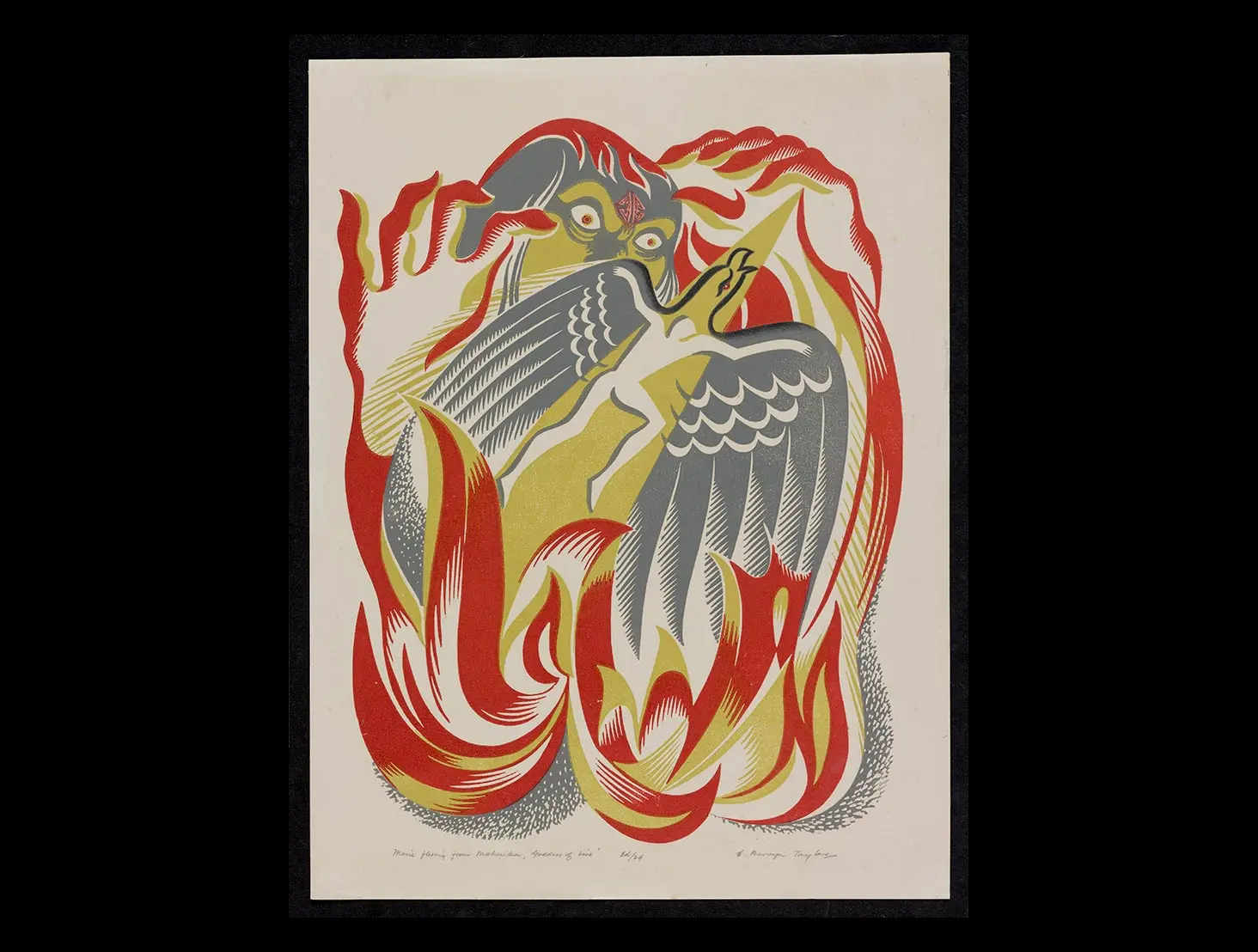Image credit: Maui Fleeing from Mahuika, Goddess of Fire, 1952 by E. Mervyn Taylor. Ref: B-036-008 Alexander Turnbull Library.

Image credit: Maui Fleeing from Mahuika, Goddess of Fire, 1952 by E. Mervyn Taylor. Ref: B-036-008 Alexander Turnbull Library.

Pūrākau (Māori legends and origin stories) and atua (gods) play an important role in understanding te ao Māori. They are also a rich resource for artists and writers. Find out more, and explore our collections and curated resources.
This linocut print by Mervyn Taylor (1906–1964) is one of my favourite images in the Turnbull collection. I first discovered it when researching for the exhibition Wāhine: Beyond the Dusky Maiden, which showed in the Turnbull Gallery in 2017. The exhibition’s kaupapa was to expand knowledge and perceptions about Māori women beyond the stereotypes. Taylor’s artwork calls to mind the way in which Māori legends and origin stories help us understand the traditional world and values of our ancestors, including the importance of the role of women, often seen through qualities and actions of atua wāhine (female deities).
Turnbull collections feature various stories of atua wāhine that offer a glimpse into the high esteem in which wāhine are held within te ao Māori. On a spiritual level, our voices can bridge spaces between the realms of the living and the dead; our wombs are the whare tangata, the house of humanity, ensuring our survival as a people. Ka wani kē!
To preface this story, the demi-god Māui goes to his grandmother Mahuika, to ask her for her gift of fire. He knows it is a finite resource, flickering away in each of her fingernails. Māui, being Māui, extinguishes the first nail on purpose and then repeats the process until he has taken possession of the fire from Mahuika’s last nail. At this point, Mahuika realises she’s been duped and unleashes her inferno upon him.
Fortunately for Māui, he can transform himself into a hawk, a power given to him by — guess what — another female relative, Hinearoraki (in a South Island version of the kōrero). Taylor perfectly captures Māui’s moment of transformation from man to bird. I also love the fact that Mahuika’s hand on the right resembles mountains, a hint of Papatūānuku, the Earth mother. As far as fire was concerned, luckily for us its last seeds were hidden in the kaikōmako and other trees, woods used for fire-making.
Taylor’s work is strongly represented in the Turnbull Library. He was a prominent artist in the mid-twentieth century who endeavoured to capture the essence of Aotearoa New Zealand culture visually at around the time that composer Douglas Lilburn was attempting to do the same through music. Taylor also played a supporting role in the lives of artists such as Cliff Whiting and Para Matchitt, influencing a generation of Māori visual artists.
Story written by: Ariana Tikao
Copyright: Turnbull Endowment Trust
Mervyn Taylor contributed to a nationalist movement in the arts, and became well known for his New Zealand landscapes, botanical artworks and depictions of Māori legends, mostly in the form of wood-cut engravings.
Read connected stories from Te Kupenga:
Explore the Alexander Turnbull Library collections further:
Topic Explorer has Pūrākau (Māori myths and legends).
Many Answers has Pūrākau (Māori myths and legends).
Want to share, print or reuse one of our images? Read the guidelines for reusing Alexander Turnbull Library images.
Tikanga ā-iwi:
Te whakaritenga pāpori me te ahurea
Te ao hurihuri
Te wāhi me te taiao.
Te Takanga o Te Wā (ngā hītori o Aotearoa):
Whakapapa
Kaitiakitanga
Tūrangawaewa
Mana motuhake
Whanaungatanga.
Social sciences concepts:
Identity, culture, and organisation
Place and environment
Continuity and change.
Aotearoa New Zealand's histories:
Māori history is continuous
Colonisation and its consequences
Relationships and connections between people.